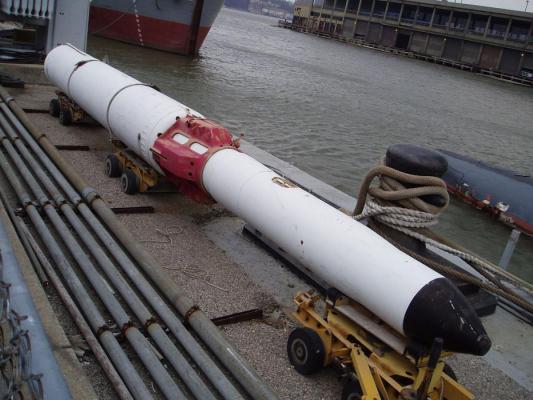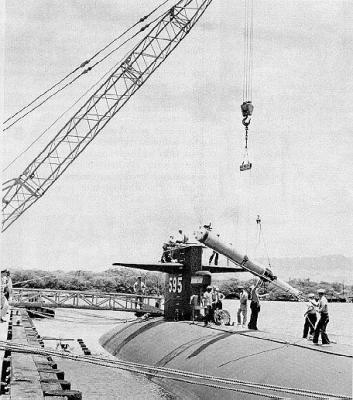In 1965, the U.S. Navy's nuclear submarines received a UUM-44 "Subroc" anti-submarine guided missile (SLBM). Until 1990, these submarines were equipped with the vast majority of U.S. multi-purpose submarines.
The work carried out in 1977-1981 to modernize the engines of the submarine allowed to extend the life cycle of these missiles for another 15 years. In addition, the Subroc submarine replacement and modernization work carried out since 1983 has allowed for the renewal of about 76% of the missile's components.
Composition:
The Subroc (see photo) consists of a warhead (BC), a W-55 nuclear depth bomb, and a solid propellant rocket motor connected by a transient device. Stabilization of the rocket in flight is provided by four T-shaped stabilizers installed in the tail part of the deep nuclear bomb, and four - in the tail part of the rocket engine, in the front part of the engine housing are placed nozzle devices that provide thrust reversal at separation of BC. The engine is equipped with four nozzles with gas deflectors. The rocket nozzle part during storage is sealed with a sealed lid, which is thrown off by the gas jet during the rocket engine launch.
The PLUR is equipped with a control system into which a flight mission is entered before launch. The missile is controlled in the active section of the trajectory by deflectors using signals from the inertial navigation subsystem.
After leaving the torpedo vehicle at a safe distance from the PL, the engine is launched, the bottom cover is opened and the missile makes controlled movement in the underwater section of the trajectory. After leaving the water, it performs a supersonic speed flight to a given area, at the design point of the trajectory on command of the onboard control system is turning on the reversible rocket engine, providing separation of the BC from the missile. The nuclear depth bomb continues its ballistic trajectory and is held on it by aerodynamic stabilizers. Once submerged in water, it explodes at a predetermined depth. The submarine's TNT equivalent of 1 to 5 kt has a radius of 5-8 kilometres.
The submarine's automated combat control system (ABCS) detects the enemy's PL and generates data for firing. It allows attacking several targets with both Subroc anti-submarine missiles and torpedoes. A conventional 533-mm torpedo vehicle is used for firing.
Characteristics:
| Range of fire maximum , km | 55 |
| The length of the rocket, m | 5.95 |
| Rocket body diameter, m | 0.533 |
| Starter weight, kg | 1850 |
Testing:
Strela-1 and Strela-1M complexes were widely exported by the USSR abroad. They were supplied to the countries-participants of the Warsaw Pact, to Yugoslavia, to the states of Asia (Iraq, Syria, North Yemen, India, Vietnam), Africa (Algeria, Angola, Benin, Egypt, Guinea, Guinea-Bissau, Libya, Madagascar, Mali, Mauritania, Mozambique) and Latin America (Cuba, Nicaragua), confirming their rather high efficiency and ease of use during military conflicts and during training firing.
The first use of the Arrow 1 SAM system was in the Bekaa Valley in southern Lebanon in 1981. In December 1983, these SAMs were shot down by American A-6E and A-7E aircraft (the latter, probably, was hit by portable SAMs of Strela-2 family). In the same year, several Arrow 1 SAM systems were captured by South African invaders in southern Angola.
Sources:
- К.Сергеев "Противолодочные ракетные комплексы" , Зарубежное военное обозрение N7, 1989 год
- http://bwana.ru/?p=5606


